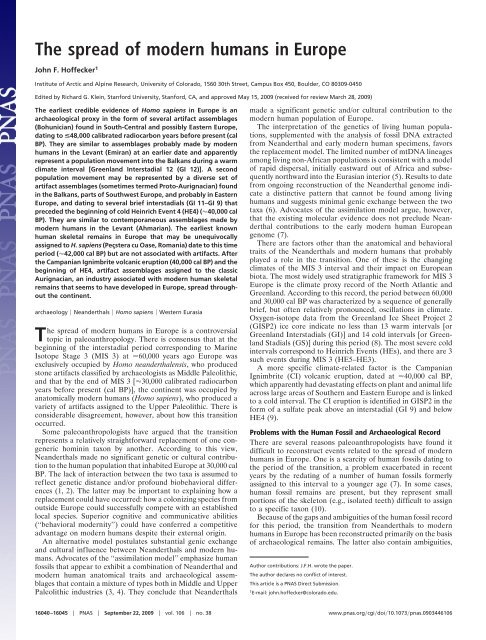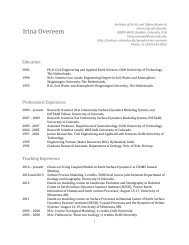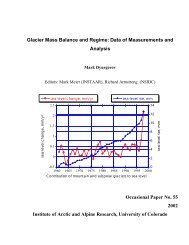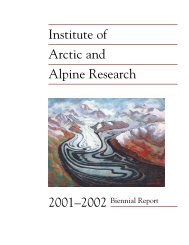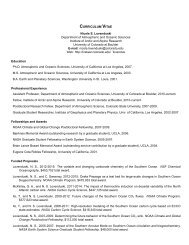The spread of modern humans in Europe - Proceedings of the ...
The spread of modern humans in Europe - Proceedings of the ...
The spread of modern humans in Europe - Proceedings of the ...
You also want an ePaper? Increase the reach of your titles
YUMPU automatically turns print PDFs into web optimized ePapers that Google loves.
<strong>The</strong> <strong>spread</strong> <strong>of</strong> <strong>modern</strong> <strong>humans</strong> <strong>in</strong> <strong>Europe</strong>John F. H<strong>of</strong>fecker 1Institute <strong>of</strong> Arctic and Alp<strong>in</strong>e Research, University <strong>of</strong> Colorado, 1560 30th Street, Campus Box 450, Boulder, CO 80309-0450Edited by Richard G. Kle<strong>in</strong>, Stanford University, Stanford, CA, and approved May 15, 2009 (received for review March 28, 2009)<strong>The</strong> earliest credible evidence <strong>of</strong> Homo sapiens <strong>in</strong> <strong>Europe</strong> is anarchaeological proxy <strong>in</strong> <strong>the</strong> form <strong>of</strong> several artifact assemblages(Bohunician) found <strong>in</strong> South-Central and possibly Eastern <strong>Europe</strong>,dat<strong>in</strong>g to
however, and many artifact assemblages dat<strong>in</strong>g to this periodcannot be firmly attributed to one taxon or <strong>the</strong> o<strong>the</strong>r. <strong>The</strong>se<strong>in</strong>clude assemblages that are not associated with diagnostichuman fossils and conta<strong>in</strong> a comb<strong>in</strong>ation <strong>of</strong> artifact typestraditionally assigned to Middle and Upper Paleolithic. <strong>The</strong>y are<strong>of</strong>ten <strong>in</strong>terpreted as manifestations <strong>of</strong> cultural <strong>in</strong>fluence betweenNeanderthals and <strong>modern</strong> <strong>humans</strong> (11), but <strong>the</strong>re areo<strong>the</strong>r reasons typical Middle and Upper Paleolithic artifactforms might be found toge<strong>the</strong>r <strong>in</strong> <strong>the</strong> same occupation (12).Although stone blade technology is traditionally associated withUpper Paleolithic <strong>in</strong>dustries, it became apparent many years agothat Middle Paleolithic <strong>in</strong>dustries <strong>in</strong> various parts <strong>of</strong> Eurasiayield evidence <strong>of</strong> blade production. Blade manufacture is welldocumented <strong>in</strong> <strong>the</strong> Middle Paleolithic <strong>of</strong> <strong>Europe</strong> and <strong>the</strong> NearEast (13, 14).If Neanderthals produced at least some <strong>of</strong> <strong>the</strong> stone artifactforms found <strong>in</strong> Upper Paleolithic assemblages, anatomically<strong>modern</strong> <strong>humans</strong> cont<strong>in</strong>ued to manufacture and use many typicalMiddle Paleolithic forms long after <strong>the</strong> transition. Production <strong>of</strong>side-scrapers, po<strong>in</strong>ts, small bifaces, and o<strong>the</strong>r such forms cont<strong>in</strong>ued<strong>in</strong>to <strong>the</strong> Upper Paleolithic and post-Paleolithic <strong>in</strong>dustries.In North America, such artifacts are common <strong>in</strong> Paleo<strong>in</strong>diansites, where <strong>the</strong>y are <strong>of</strong>ten associated with <strong>the</strong> kill<strong>in</strong>g andbutcher<strong>in</strong>g <strong>of</strong> large mammals (e.g., refs. 15 and 16). In <strong>Europe</strong>,Middle Paleolithic tool types also are present <strong>in</strong> Upper Paleolithicassemblages, but usually <strong>in</strong> low percentages <strong>in</strong> <strong>the</strong> naturalshelters <strong>of</strong> Western <strong>Europe</strong>. In <strong>the</strong> open-air sites (and somenatural shelters) <strong>of</strong> Central and Eastern <strong>Europe</strong>, <strong>the</strong>y are morecommon and <strong>of</strong>ten abundant (17).At both open-air localities and natural shelters where UpperPaleolithic occupations directly overlie those <strong>of</strong> <strong>the</strong> MiddlePaleolithic, <strong>the</strong> mix<strong>in</strong>g <strong>of</strong> artifacts from different levels representsano<strong>the</strong>r potential source <strong>of</strong> assemblages conta<strong>in</strong><strong>in</strong>g typicalforms from both <strong>in</strong>dustries. In addition to potential deposition<strong>of</strong> Neanderthal and <strong>modern</strong> human artifacts on <strong>the</strong> same surface,postdepositional mix<strong>in</strong>g <strong>of</strong> surface and buried artifacts caused bytrampl<strong>in</strong>g or frost action is possible (18).Ano<strong>the</strong>r problem is <strong>the</strong> dat<strong>in</strong>g <strong>of</strong> sites and occupation levels<strong>in</strong>habited dur<strong>in</strong>g <strong>the</strong> transition period. Much <strong>of</strong> MIS 3 liesbeyond <strong>the</strong> effective range <strong>of</strong> radiocarbon and many dates(especially on bone) likely have been contam<strong>in</strong>ated by youngercarbon. Even dates that appear to be valid must be calibrated toaccount for <strong>the</strong> effects <strong>of</strong> past fluctuations <strong>in</strong> atmosphericradiocarbon, especially elevated dur<strong>in</strong>g <strong>the</strong> cosmogenic nuclidepeak at 40,000 cal BP. In this article, radiocarbon measurementshave been calibrated with <strong>the</strong> CalPal-2007 curve (19). <strong>The</strong>application <strong>of</strong> o<strong>the</strong>r dat<strong>in</strong>g techniques, <strong>in</strong>clud<strong>in</strong>g opticalstimulatedlum<strong>in</strong>escence and electron sp<strong>in</strong> resonance, has improvedchronological control, and several wide<strong>spread</strong> chronostratigraphicmarkers, such as <strong>the</strong> CI volcanic tephra and <strong>the</strong>Laschamp paleomagnetic excursion, have provided additionalcontrol <strong>in</strong> some places (9).Modern Humans as a Coloniz<strong>in</strong>g SpeciesModern <strong>humans</strong> entered <strong>Europe</strong> as a coloniz<strong>in</strong>g species andprobably were characterized by comparatively low populationdensity as <strong>the</strong>y expanded <strong>in</strong>to previously unoccupied territoryand adapted to new environmental conditions (20). Low densitymight be expressed <strong>in</strong> terms <strong>of</strong> smaller residential group sizeand/or larger home ranges and higher mobility requirements.<strong>The</strong> <strong>in</strong>itial phase <strong>of</strong> <strong>modern</strong> human settlement <strong>in</strong> <strong>Europe</strong><strong>the</strong>refore could be represented by a relatively small number <strong>of</strong>archaeological sites and human skeletal rema<strong>in</strong>s per unit area.<strong>The</strong>ir visibility probably would be even lower <strong>in</strong> landscapeswhere natural shelters are scarce or absent.However, <strong>the</strong>re is reason to believe that <strong>modern</strong> <strong>humans</strong> hadacquired some unique abilities to colonize new environments.Behavioral <strong>modern</strong>ity is <strong>of</strong>ten identified with <strong>the</strong> use <strong>of</strong> symbols(21), which is most clearly manifest <strong>in</strong> syntactical language.Language and o<strong>the</strong>r uses <strong>of</strong> symbols are, however, part <strong>of</strong> abroader capacity to create complex, hierarchically organizedstructures (sometimes labeled recursion) <strong>in</strong> a variety <strong>of</strong> mediaboth symbolic and nonsymbolic (22). <strong>The</strong> latter <strong>in</strong>clude technology,which exhibits a pattern <strong>of</strong> accelerat<strong>in</strong>g <strong>in</strong>novation andexpand<strong>in</strong>g complexity dur<strong>in</strong>g <strong>the</strong> Upper Paleolithic (23). <strong>The</strong> use<strong>of</strong> symbols also may have conferred some unique organizationalabilities on <strong>modern</strong> <strong>humans</strong> (24), and <strong>the</strong> creation <strong>of</strong> noveltechnologies and organizational structures may have played asignificant role <strong>in</strong> <strong>the</strong> dispersal <strong>of</strong> <strong>modern</strong> <strong>humans</strong> and <strong>the</strong>irseem<strong>in</strong>gly rapid colonization <strong>of</strong> a variety <strong>of</strong> habitats and climatezones.Ano<strong>the</strong>r factor is <strong>the</strong> presence <strong>of</strong> competitor species. BothNeanderthals and hyenas represent likely competitors for <strong>modern</strong><strong>humans</strong> <strong>in</strong> <strong>Europe</strong>, especially with respect to large mammalprey. With this <strong>in</strong> m<strong>in</strong>d, it should be noted that comparativeanalysis <strong>of</strong> stable isotope values for Neanderthal and hyena bonefrom a cave <strong>in</strong> France (late MIS 3) suggests that emphasis onsuperherbivores (mammoth and rh<strong>in</strong>oceros) by <strong>the</strong> former reducedresource competition with hyenas (25). As for <strong>modern</strong> <strong>humans</strong>,<strong>the</strong>re is evidence for exploitation <strong>of</strong> smaller vertebrates, whichmight have reduced niche overlap with both competitors (26).South-Central <strong>Europe</strong><strong>The</strong> earliest credible evidence for <strong>modern</strong> <strong>humans</strong> <strong>in</strong> <strong>Europe</strong> isagroup<strong>of</strong>artifactassemblagesfound<strong>in</strong>South-Central<strong>Europe</strong>,assigned to <strong>the</strong> Bohunician <strong>in</strong>dustry, that are similar to assemblages<strong>of</strong> comparable age <strong>in</strong> <strong>the</strong> Near East associated <strong>in</strong>directlywith skeletal rema<strong>in</strong>s <strong>of</strong> <strong>modern</strong> <strong>humans</strong>. <strong>The</strong>y are found at <strong>the</strong>type site <strong>of</strong> Brno-Bohunice and Stránská skála (Moravia), BachoKiro and Temnata Cave (Bulgaria), Dzierzyslaw (Poland), ando<strong>the</strong>rs (27, 28). <strong>The</strong>y conta<strong>in</strong> Levallois cores used to produceflakes and blades with hard-hammer percussion and retouchedpieces <strong>in</strong>clud<strong>in</strong>g a variety <strong>of</strong> side-scrapers, po<strong>in</strong>ts, end-scrapers,and simple bur<strong>in</strong>s; some assemblages also conta<strong>in</strong> bifacial leafshapedpo<strong>in</strong>ts (29). An associated human mandible fragmentrecovered from layer 11 at Bach Kiro is <strong>of</strong> uncerta<strong>in</strong> taxonomicaffiliation (10).Although a case for local Middle Paleolithic orig<strong>in</strong> has beenmade (30), many archaeologists perceive stronger similaritiesbetween <strong>the</strong> Bohunician and contemporaneous assemblages <strong>in</strong><strong>the</strong> Near East, specifically at Bocher Tachtit, layers 1–3 (Israel),Ksar Akil, layers XXV-XXI (Lebanon), and Üçağizli Cave,layers F-H (Turkey), and little evidence <strong>of</strong> cont<strong>in</strong>uity with lateMiddle Paleolithic <strong>in</strong>dustries <strong>of</strong> Central <strong>Europe</strong> (31, 32). <strong>The</strong>Near Eastern assemblages, which are assigned to <strong>the</strong> Emiran<strong>in</strong>dustry [or simply Initial Upper Paleolithic (IUP)], lack associatedhuman skeletal rema<strong>in</strong>s. <strong>The</strong>y appear, however, to representpart <strong>of</strong> a local developmental cont<strong>in</strong>uum that subsequentlyyielded a related <strong>in</strong>dustry (Ahmarian) associated with <strong>modern</strong>human rema<strong>in</strong>s <strong>in</strong> layer XVII at Ksar Akil (33). Moreover, <strong>the</strong>Emiran reflects broader trends <strong>in</strong> technology observed <strong>in</strong> NorthAfrica at older sites like Taramsa 1 (Nile Valley), which conta<strong>in</strong>s<strong>modern</strong> human rema<strong>in</strong>s dated to 75,000 years ago (34).Assemblages assigned to <strong>the</strong> Bohunician <strong>in</strong> South-Central<strong>Europe</strong> are dated by radiocarbon and lum<strong>in</strong>escence to 48,000–40,000 cal BP (35). <strong>The</strong>y are associated with two buried soils thatdate to <strong>the</strong> MIS 3 <strong>in</strong>terval and correlate with GI 12–GI 9 <strong>in</strong> <strong>the</strong>Greenland ice core record. <strong>The</strong> Bohunician appears at <strong>the</strong>beg<strong>in</strong>n<strong>in</strong>g <strong>of</strong> a major warm <strong>in</strong>terval (GI 12) and term<strong>in</strong>atesbefore a major cold period (HE4). <strong>The</strong> apparent l<strong>in</strong>k between<strong>the</strong> Bohunician and GI 12 may be significant, because one <strong>of</strong> <strong>the</strong>strik<strong>in</strong>g characteristics <strong>of</strong> this <strong>in</strong>dustry, given its postulated statusas a proxy for <strong>the</strong> <strong>in</strong>itial movement <strong>of</strong> <strong>modern</strong> <strong>humans</strong> <strong>in</strong>to<strong>Europe</strong>, is <strong>the</strong> scarcity <strong>of</strong> evidence for <strong>in</strong>novative technology.With <strong>the</strong> exception <strong>of</strong> a perforator from layer 11 <strong>of</strong> Bacho Kiro(36), Bohunician sites lack bone implements and o<strong>the</strong>r evidenceANTHROPOLOGY SPECIAL FEATUREH<strong>of</strong>fecker PNAS September 22, 2009 vol. 106 no. 38 16041
(e.g., large numbers <strong>of</strong> small mammal rema<strong>in</strong>s) that might reflect<strong>in</strong>novations to help <strong>modern</strong> <strong>humans</strong> cope with new environmentalconditions.<strong>The</strong> scarcity <strong>of</strong> such evidence could be partly because mostBohunician sites are open-air localities and some <strong>of</strong> <strong>the</strong>m appearto have been workshop sites. Isolated bone and antler implementshave been recovered from Emiran (or IUP) levels at KsarAkil and Üçağizli Cave (33, 37). Moreover, evidence for possibleorganizational adaptations <strong>in</strong> <strong>the</strong> form <strong>of</strong> personal ornaments ispresent <strong>in</strong> layer 11 at Bacho Kiro and <strong>in</strong> <strong>the</strong> Emiran sites (33, 36,37), and nonstone implements, personal ornaments, and signs <strong>of</strong>an expand<strong>in</strong>g economy are associated with anatomically <strong>modern</strong><strong>humans</strong> <strong>in</strong> an earlier African context (38).<strong>The</strong>re are also sites <strong>in</strong> Central <strong>Europe</strong> broadly contemporaneouswith <strong>the</strong> Bohunician that yield bone artifacts. Many <strong>of</strong><strong>the</strong>m are classified as Szeletian, an <strong>in</strong>dustry that is most closelyassociated with a group <strong>of</strong> caves <strong>in</strong> <strong>the</strong> Bükk Mounta<strong>in</strong>s <strong>of</strong>Hungary, but is represented at sites <strong>in</strong> Moravia and sou<strong>the</strong>rnPoland as well (39). <strong>The</strong> assemblages conta<strong>in</strong> leaf-shaped stonepo<strong>in</strong>ts, bone po<strong>in</strong>ts, side-scrapers, and o<strong>the</strong>rs. Associated humanrema<strong>in</strong>s <strong>in</strong>clude isolated teeth from layer 4 at Upper RemeteCave (Hungary) and a tooth germ from Dzeravá skála (Slovakia),which are ambiguous <strong>in</strong> terms <strong>of</strong> taxonomic affiliation (10).Despite <strong>the</strong> ambiguity <strong>of</strong> <strong>the</strong> skeletal rema<strong>in</strong>s and <strong>the</strong> presence<strong>of</strong> bone po<strong>in</strong>ts, <strong>the</strong> Szeletian is widely assumed to be <strong>the</strong> product<strong>of</strong> local Neanderthals (11, 12). <strong>The</strong> assumption is based on <strong>the</strong>fact that typical Middle Paleolithic artifacts are found <strong>in</strong> <strong>the</strong>assemblages and <strong>the</strong> pattern appears to be analogous to that <strong>of</strong><strong>the</strong> Chatelperronian, a group <strong>of</strong> assemblages from <strong>the</strong> Franco-Cantabrian region that conta<strong>in</strong> a mixture <strong>of</strong> Middle and UpperPaleolithic artifacts and are associated with Neanderthal rema<strong>in</strong>s(40). Many Szeletian sites conta<strong>in</strong> small functionally specializedassemblages that are more parsimoniously expla<strong>in</strong>ed as tool kitsrelated to large mammal hunt<strong>in</strong>g and carcass process<strong>in</strong>g (41).Anewset<strong>of</strong>artifactassemblagesappear<strong>in</strong>South-Central(and Southwestern) <strong>Europe</strong> as early as 45,000 cal BP <strong>of</strong>tenreferred to as Proto-Aurignacian. <strong>The</strong>y vary widely <strong>in</strong> compositionand <strong>the</strong> term Proto-Aurignacian may be more useful withrespect to archaeological chrono-stratigraphy than <strong>in</strong>dustrial/cultural classification. In Bulgaria, <strong>the</strong>y are represented atTemnata Cave (unit 4, levels C-A) by occupations conta<strong>in</strong><strong>in</strong>gend-scrapers (<strong>in</strong>clud<strong>in</strong>g some car<strong>in</strong>ate forms), Font-Yves po<strong>in</strong>ts,and o<strong>the</strong>rs buried below <strong>the</strong> CI tephra and dat<strong>in</strong>g to one or more<strong>in</strong>terstadials (GI 11–GI 9?) (42). <strong>The</strong> Proto-Aurignacian isbetter known <strong>in</strong> Italy and o<strong>the</strong>r parts <strong>of</strong> Southwest <strong>Europe</strong>(described below), where it is represented by assemblages conta<strong>in</strong><strong>in</strong>ghigh percentages (up to 85%) <strong>of</strong> retouched bladelets.Some Italian Proto-Aurignacian assemblages conta<strong>in</strong> higherpercentages <strong>of</strong> more typical Aurignacian artifacts, and manyyield bone and antler artifacts and perforated mar<strong>in</strong>e shells (43).<strong>The</strong> Proto-Aurignacian seems to have close ties with <strong>the</strong>Ahmarian <strong>in</strong>dustry <strong>of</strong> <strong>the</strong> Near East <strong>in</strong> much <strong>the</strong> same way that<strong>the</strong> Bohunician is tied to <strong>the</strong> preced<strong>in</strong>g Emiran. As alreadynoted, <strong>the</strong> Ahmarian is associated with <strong>modern</strong> human rema<strong>in</strong>s(33), and for this reason, and <strong>the</strong> scarcity <strong>of</strong> Middle Paleolithicartifact types <strong>in</strong> <strong>the</strong> assemblages, <strong>the</strong>re is a consensus that <strong>the</strong>Proto-Aurignacian is a proxy for <strong>modern</strong> <strong>humans</strong>, despite <strong>the</strong>absence <strong>of</strong> unambiguous skeletal material (1, 30). If <strong>the</strong> Bohunicianrepresents <strong>the</strong> earliest credible evidence for <strong>modern</strong><strong>humans</strong> <strong>in</strong> <strong>Europe</strong>, <strong>the</strong> Proto-Aurignacian would seem to representa second population movement from <strong>the</strong> Near East.<strong>The</strong> earliest <strong>modern</strong> human skeletal rema<strong>in</strong>s <strong>in</strong> <strong>Europe</strong> dateto <strong>the</strong> same time period and are plausibly l<strong>in</strong>ked to <strong>the</strong> Proto-Aurignacian, despite <strong>the</strong> lack <strong>of</strong> associated artifacts. At <strong>the</strong>Peçstera cu Oase <strong>in</strong> Romania, a nearly complete mandible(conta<strong>in</strong><strong>in</strong>g 5 molars) and nearly complete cranium, are dated to42,000 cal BP and GI 11 (3, 44). <strong>The</strong>y are assigned toanatomically <strong>modern</strong> <strong>humans</strong> but exhibit at least one feature thatis common among H. neanderthalensis (bridg<strong>in</strong>g <strong>of</strong> mandibularforamen); younger specimens from two o<strong>the</strong>r Romanian caves(Cioclov<strong>in</strong>a, Muierii) also are said to exhibit some typicalNeanderthal characteristics (3, 44).Unlike <strong>the</strong> Bohunician and Proto-Aurignacian, <strong>the</strong> classicAurignacian has no obvious antecedent <strong>in</strong> <strong>the</strong> Near East. Somebelieve that it emerges <strong>in</strong> South-Central <strong>Europe</strong> and subsequently<strong>spread</strong>s to o<strong>the</strong>r parts <strong>of</strong> western Eurasia (45). <strong>The</strong> roots<strong>of</strong> <strong>the</strong> Aurignacian would seem to lie <strong>in</strong> <strong>the</strong> sequence <strong>of</strong>assemblages <strong>in</strong> Bulgarian caves described above, and possiblyo<strong>the</strong>r sites/regions (e.g., Willendorf <strong>in</strong> Austria), that antedate40,000 cal BP (27). <strong>The</strong> wider <strong>spread</strong> <strong>of</strong> <strong>the</strong> classic Aurignacianapparently took place <strong>in</strong> <strong>the</strong> aftermath <strong>of</strong> <strong>the</strong> CI eruption andbeg<strong>in</strong>n<strong>in</strong>g <strong>of</strong> <strong>the</strong> HE4 cold <strong>in</strong>terval. In Moravia, an Aurignacianassemblage at Stránská skála (layer 4) is radiocarbon-dated to37,000 cal BP (29). Modern human rema<strong>in</strong>s (cranium, maxilla,and o<strong>the</strong>r skeletal parts) associated with bone po<strong>in</strong>ts and a fewstone artifacts assigned to <strong>the</strong> Aurignacian from <strong>the</strong> cave <strong>of</strong>Mladeč yieldedslightlyyoungerdates(46).Eastern <strong>Europe</strong>At least two <strong>of</strong> <strong>the</strong> major archaeological entities l<strong>in</strong>ked to <strong>the</strong><strong>spread</strong> <strong>of</strong> <strong>modern</strong> <strong>humans</strong> <strong>in</strong> South-Central <strong>Europe</strong> (i.e., Bohunicianand Aurignacian) are present <strong>in</strong> Eastern <strong>Europe</strong>. <strong>The</strong>third (Proto-Aurignacian) has not been widely recognized butmay be present on <strong>the</strong> central pla<strong>in</strong>. As <strong>in</strong> South-Central <strong>Europe</strong>,only <strong>the</strong> youngest <strong>of</strong> <strong>the</strong>se entities (Aurignacian) is associatedwith skeletal rema<strong>in</strong>s that may be assigned unequivocally toanatomically <strong>modern</strong> <strong>humans</strong>. <strong>The</strong> o<strong>the</strong>r two are archaeologicalproxies for <strong>modern</strong> <strong>humans</strong>, and <strong>the</strong> oldest <strong>of</strong> <strong>the</strong>se (Bohunician)is problematic as such.ABohunicianartifactassemblagehasbeenidentified<strong>in</strong><strong>the</strong>lowest layer at Kulychivka <strong>in</strong> western Ukra<strong>in</strong>e (47). It comprisesLevallois blade cores and typical Upper Paleolithic subprismaticcores used to generate crested blades; Upper Paleolithic tooltypes predom<strong>in</strong>ate (48). <strong>The</strong> lower layer at Kulychivka underliesaburiedsoilthatcorrelateswith<strong>the</strong>end<strong>of</strong>MIS3andyieldedaproblematic 14 Cdate<strong>of</strong>35,000 cal BP; it is generally thoughtto be younger than <strong>the</strong> Bohunician <strong>of</strong> South-Central <strong>Europe</strong>. Anolder Bohunician <strong>in</strong>dustry may be represented on a Don Rivertributary at Shlyakh. <strong>The</strong> artifacts are similar to Emiran assemblages<strong>in</strong> <strong>the</strong> Levant and have been labeled ‘‘transitional’’ from<strong>the</strong> Middle to <strong>the</strong> Upper Paleolithic. <strong>The</strong>y are associated with <strong>the</strong>Laschamp paleomagnetic excursion and appear to date to44,000 cal BP (49).Kostenki on <strong>the</strong> Middle Don River (Russia) conta<strong>in</strong>s a lengthysequence <strong>of</strong> early Upper Paleolithic (EUP) occupations, <strong>in</strong>clud<strong>in</strong>gsome that underlie <strong>the</strong> CI tephra and date to 40,000 cal BP(17, 50). Kostenki conta<strong>in</strong>s a unique EUP landscape <strong>of</strong> varioustypes <strong>of</strong> sites, distributed along several side-valley rav<strong>in</strong>es <strong>in</strong>cised<strong>in</strong>to <strong>the</strong> west bank <strong>of</strong> <strong>the</strong> ma<strong>in</strong> valley. Active spr<strong>in</strong>gs <strong>in</strong> <strong>the</strong>rav<strong>in</strong>es probably attracted large mammals to <strong>the</strong> area, and some<strong>of</strong> <strong>the</strong> sites represent kill-butchery locations. <strong>The</strong> earliest assemblagesappear to be related to <strong>the</strong> Proto-Aurignacian movement<strong>in</strong>to South-Central <strong>Europe</strong> or someth<strong>in</strong>g comparable.Artifacts recovered from with<strong>in</strong> <strong>the</strong> CI tephra at Kostenki 14comprise backed bladelets, retouched blades, and personalornaments (decorated bone and perforated shell and fox teeth)(17, 51). This assemblage is similar to those from Italy andadjo<strong>in</strong><strong>in</strong>g areas <strong>of</strong> <strong>the</strong> Mediterranean coast that are classified asProto-Aurignacian and tied to <strong>the</strong> Ahmarian <strong>of</strong> <strong>the</strong> Near East. <strong>The</strong>Proto-Aurignacian sites are buried below <strong>the</strong> CI tephra and date to<strong>the</strong> brief <strong>in</strong>terstadials that preceded HE4 (GI 11–GI 9) (50).Both Kostenki 14 and 17 also conta<strong>in</strong> assemblages buriedbelow <strong>the</strong> CI tephra that appear to represent one or more local<strong>in</strong>dustries currently unknown <strong>in</strong> o<strong>the</strong>r parts <strong>of</strong> <strong>Europe</strong> (17, 50).<strong>The</strong>y conta<strong>in</strong> prismatic blade cores, bur<strong>in</strong>s, some end-scrapers,personal ornaments (perforated fox teeth and fossils), and16042 www.pnas.orgcgidoi10.1073pnas.0903446106 H<strong>of</strong>fecker
human dispersal along <strong>the</strong> Danube corridor, although it shouldbe noted that formerly associated human skeletal rema<strong>in</strong>s havebeen redated to younger time periods (7). Teeth associated withan early Aurigancian assemblage at Brassempouy (France) arenow assigned to <strong>modern</strong> <strong>humans</strong> (62).Evidence for assimilation or acculturation is reported from <strong>the</strong>Franco-Cantabrian region <strong>in</strong> <strong>the</strong> form <strong>of</strong> assemblages (Chatelperronian)compris<strong>in</strong>g Middle and Upper Paleolithic tool types,along with personal ornaments <strong>in</strong> at least one site (40). Unlike<strong>the</strong> Szeletian and Uluzzian sites described above, <strong>the</strong>se artifactsare associated with human skeletal rema<strong>in</strong>s that may be firmlyclassified as Neanderthal at two sites. <strong>The</strong>ir stratigraphic position<strong>in</strong> relation to <strong>the</strong> Aurignacian has been disputed, however.Some believe that <strong>the</strong>y are contemporaneous and <strong>in</strong>terstratifiedwith early Aurignacian assemblages (1), whereas o<strong>the</strong>rs suggestthat <strong>the</strong>y significantly antedate <strong>the</strong> latter and represent an<strong>in</strong>dependent development on <strong>the</strong> part <strong>of</strong> <strong>the</strong> local Neanderthalsbefore <strong>the</strong> appearance <strong>of</strong> <strong>modern</strong> <strong>humans</strong> (30). Yet ano<strong>the</strong>r view<strong>of</strong> <strong>the</strong> Chatelperronian is that <strong>the</strong> assemblages represent amixture (perhaps caused <strong>in</strong> part by cryoturbation dur<strong>in</strong>g HE4)<strong>of</strong> <strong>the</strong> latest Middle and earliest Upper Paleolithic occupations(12, 63).Summary and Conclusions<strong>The</strong> earliest evidence <strong>of</strong> anatomically <strong>modern</strong> <strong>humans</strong> <strong>in</strong> <strong>Europe</strong>is currently dated to 48,000 cal BP and <strong>the</strong> beg<strong>in</strong>n<strong>in</strong>g <strong>of</strong> <strong>the</strong> GI12 warm <strong>in</strong>terval. It is based on artifact assemblages (Bohunician)that are similar to an earlier <strong>in</strong>dustry <strong>in</strong> <strong>the</strong> Near East(Emiran) probably produced by <strong>modern</strong> <strong>humans</strong>. Bohuniciansites are present <strong>in</strong> South-Central <strong>Europe</strong> (27, 29, 32) andpossibly Eastern <strong>Europe</strong> as well, dur<strong>in</strong>g this <strong>in</strong>terval. Manypaleoanthropologists will want to see this conclusion supportedby discovery <strong>of</strong> <strong>modern</strong> human skeletal rema<strong>in</strong>s <strong>in</strong> <strong>the</strong>se sites orat least <strong>in</strong> a context that may be dated to <strong>the</strong> same period.Apossiblesecondmovement<strong>of</strong><strong>modern</strong><strong>humans</strong><strong>in</strong>to<strong>Europe</strong>may be represented by ano<strong>the</strong>r group <strong>of</strong> artifact assemblagesthat date to as early as 45,000–44,000 cal BP and GS11/GI 11. <strong>The</strong>y vary significantly <strong>in</strong> composition and aresometimes referred to as Proto-Aurignacian (27, 43, 50, 64).Many are similar to a contemporaneous <strong>in</strong>dustry <strong>in</strong> <strong>the</strong> NearEast (Ahmarian) manufactured by <strong>modern</strong> <strong>humans</strong> (1, 33).Proto-Aurignacian assemblages are found <strong>in</strong> Southwest andSouth-Central <strong>Europe</strong> and seem to be present <strong>in</strong> Eastern<strong>Europe</strong> at this time (50). Although <strong>the</strong> oldest known <strong>modern</strong>human skeletal rema<strong>in</strong>s <strong>in</strong> <strong>Europe</strong> date to this <strong>in</strong>terval, <strong>the</strong>yare not associated with artifacts (44). Never<strong>the</strong>less, <strong>the</strong> Proto-Aurignacian is widely attributed to H. sapiens on <strong>the</strong> basis <strong>of</strong>its apparent l<strong>in</strong>k to <strong>the</strong> Ahmarian and <strong>the</strong> artifacts, which<strong>in</strong>clude small backed bladelets and po<strong>in</strong>ts, personal ornaments,and bone/antler implements (30, 57).Both <strong>the</strong> Bohunician and Proto-Aurignacian sites probablyrepresent <strong>modern</strong> human population movements from <strong>the</strong> NearEast <strong>in</strong>to <strong>Europe</strong> via <strong>the</strong> Balkans. This conclusion is based on <strong>the</strong>proximity <strong>of</strong> South-Central <strong>Europe</strong> to <strong>the</strong> most probable source<strong>of</strong> <strong>the</strong> two sets <strong>of</strong> assemblages (i.e., <strong>the</strong> Levant). Central Asia isconsidered ano<strong>the</strong>r possible source <strong>of</strong> <strong>modern</strong> human populations<strong>in</strong> <strong>Europe</strong>, especially for adjo<strong>in</strong><strong>in</strong>g Eastern <strong>Europe</strong> (65).<strong>The</strong> Iberian Pen<strong>in</strong>sula and <strong>the</strong> Caucasus seem less likely routes,because local Neanderthal populations were present <strong>in</strong> bothareas until relatively late (66, 67). After <strong>the</strong> onset <strong>of</strong> cold HE4at 40,000 cal BP, a new <strong>in</strong>dustry (Aurignacian) possiblydeveloped <strong>in</strong> South-Central <strong>Europe</strong> <strong>spread</strong> rapidly throughout<strong>the</strong> cont<strong>in</strong>ent. Aurignacian assemblages are associated with <strong>the</strong>rema<strong>in</strong>s <strong>of</strong> <strong>modern</strong> <strong>humans</strong> <strong>in</strong> Western, Central, and Eastern<strong>Europe</strong> (1, 7, 10, 46, 52, 62).Although <strong>the</strong> Bohunician sites yield little direct or <strong>in</strong>directevidence <strong>of</strong> technological <strong>in</strong>novation, this may be caused <strong>in</strong> partby <strong>the</strong> functional and preservation biases <strong>of</strong> open-air lithicworkshops. If <strong>the</strong> caves conta<strong>in</strong><strong>in</strong>g bone po<strong>in</strong>ts traditionallyassigned to <strong>the</strong> Szeletian <strong>in</strong>dustry (11) are considered part <strong>of</strong> <strong>the</strong>same phenomenon [and added to an isolated bone implement <strong>in</strong>layer 11 at Bacho Kiro (36)], nonstone implements <strong>in</strong> <strong>the</strong>se sitesare comparable to those <strong>in</strong> <strong>the</strong> related Emiran or IUP <strong>in</strong>dustry<strong>of</strong> <strong>the</strong> Levant (37). Indirect evidence for organizational adaptations<strong>in</strong> <strong>the</strong> form <strong>of</strong> personal ornaments also is present <strong>in</strong>Bacho Kiro and <strong>in</strong> <strong>the</strong> related Emiran or IUP sites <strong>of</strong> <strong>the</strong> Levant(10, 36, 24). <strong>The</strong> pattern <strong>in</strong>dicates that although <strong>modern</strong> <strong>humans</strong>seem to have <strong>in</strong>itially entered <strong>Europe</strong> dur<strong>in</strong>g a warm climate<strong>in</strong>terval (GI 12), both technological and organizational <strong>in</strong>novations,reflect<strong>in</strong>g behavioral <strong>modern</strong>ity, may have facilitated <strong>the</strong>ircolonization <strong>of</strong> new environments.<strong>The</strong> extent to which <strong>modern</strong> <strong>humans</strong> and Neanderthals <strong>in</strong><strong>Europe</strong> exchanged genetic and/or cultural traits rema<strong>in</strong>s unclear.Significant niche overlap between <strong>the</strong> two species would seem topreclude susta<strong>in</strong>ed coexistence <strong>in</strong> <strong>the</strong> same region withoutsubstantial <strong>in</strong>terbreed<strong>in</strong>g. Evidence for <strong>in</strong>terstratifications <strong>of</strong>Neanderthal and <strong>modern</strong> human occupations is limited andproblematic, and <strong>in</strong> most places, <strong>modern</strong> human occupationdebris ei<strong>the</strong>r directly overlies traces <strong>of</strong> Neanderthal occupationor <strong>the</strong>re is a hiatus between <strong>the</strong> two (57, 61). Genic exchange is<strong>in</strong>ferred from <strong>the</strong> presence <strong>of</strong> anatomical traits <strong>in</strong> <strong>modern</strong> <strong>humans</strong>keletal rema<strong>in</strong>s that are common among Neanderthals andperhaps most parsimoniously expla<strong>in</strong>ed by <strong>in</strong>terbreed<strong>in</strong>g. <strong>The</strong>setraits could have evolved among <strong>modern</strong> <strong>humans</strong>, however, <strong>in</strong><strong>the</strong> absence <strong>of</strong> genic exchange with Neanderthals. Cultural<strong>in</strong>fluences are <strong>in</strong>ferred from <strong>the</strong> co-occurrence <strong>of</strong> artifactstypically made by both taxa, or <strong>in</strong> <strong>the</strong> case <strong>of</strong> <strong>the</strong> Chatelperronian,<strong>the</strong> reported co-occurrence <strong>of</strong> artifacts typically made byone taxon with <strong>the</strong> skeletal rema<strong>in</strong>s <strong>of</strong> <strong>the</strong> o<strong>the</strong>r. <strong>The</strong>re arealternative explanations <strong>of</strong> <strong>the</strong>se co-occurrences, however, and<strong>the</strong> evidence is not conclusive (63).ACKNOWLEDGMENTS. I thank R. G. Kle<strong>in</strong>, who <strong>in</strong>vited me to contribute thisarticle to <strong>the</strong> PNAS special feature and provided helpful comments on anearlier draft and V. T. Holliday and 2 anonymous reviewers for PNAS forcomments.1. Mellars P (2006) Archeology and <strong>the</strong> dispersal <strong>of</strong> <strong>modern</strong> <strong>humans</strong> <strong>in</strong> <strong>Europe</strong>: Deconstruct<strong>in</strong>g<strong>the</strong> ‘‘Aurignacian.’’ Evol Anthropol 15:167–182.2. Kle<strong>in</strong> RG (2008) Out <strong>of</strong> Africa and <strong>the</strong> evolution <strong>of</strong> human behavior. Evol Anthropol17:267–281.3. Tr<strong>in</strong>kaus E (2007) <strong>Europe</strong>an early <strong>modern</strong> <strong>humans</strong> and <strong>the</strong> fate <strong>of</strong> <strong>the</strong> Neandertals. ProcNatl Acad Sci USA 104:7367–7372.4. d’Errico F (2003) <strong>The</strong> <strong>in</strong>visible frontier. A multiple species model for <strong>the</strong> orig<strong>in</strong> <strong>of</strong>behaviorally <strong>modern</strong>ity. Evol Anthropol 12:188–202.5. Kivisild T (2007) <strong>in</strong> Reth<strong>in</strong>k<strong>in</strong>g <strong>the</strong> Human Revolution, eds Mellars P, Boyle K, Bar-YosefO, Str<strong>in</strong>ger C (McDonald Institute, Cambridge, UK), pp 21–32.6. Max Planck Institute for Evolutionary Anthropology (2009) Draft Version <strong>of</strong> <strong>the</strong>Neandertal Genome Completed (Max Planck Institute for Evolutionary Anthropology,Leipzig, Germany).7. Tr<strong>in</strong>kaus E (2005) Early <strong>modern</strong> <strong>humans</strong>. Annu Rev Anthropol 34:207–230.8. Grootes P, Stuiver M, White J, Johnsen S, Jouzel J (1993) Comparison <strong>of</strong> oxygen isotoperecords from <strong>the</strong> GISP2 and GRIP Greenland ice cores. Nature 366:552–554.9. Fedele F, Giaccio B, Hajdas I (2008) Time scales and cultural process at 40,000 BP <strong>in</strong>light <strong>of</strong> <strong>the</strong> Campanian Ignimbrite eruption, Western Eurasia. JHumEvol55:834–857.10. Churchill S, Smith F (2000) Makers <strong>of</strong> <strong>the</strong> early Aurignacian <strong>in</strong> <strong>Europe</strong>. Yrbk PhysAnthropol 43:61–115.11. Allsworth-Jones P (1990) <strong>in</strong> <strong>The</strong> Emergence <strong>of</strong> Modern Humans, ed Mellars P (Ed<strong>in</strong>burghUniv Press, Ed<strong>in</strong>burgh), pp 160–242.12. Bar-Yosef O (2007) <strong>in</strong> Reth<strong>in</strong>k<strong>in</strong>g <strong>the</strong> Human Revolution, eds Mellars P, Boyle K,Bar-Yosef O, Str<strong>in</strong>ger C (McDonald Institute, Cambridge, UK), pp 207–217.13. Meignen L (2000) Early Middle Palaeolithic blade technology <strong>in</strong> southwestern Asia.Acta Anthropol S<strong>in</strong>ica 19:158–168.14. Mellars P (1996) <strong>The</strong> Neanderthal Legacy (Pr<strong>in</strong>ceton Univ Press, Pr<strong>in</strong>ceton).15. Hester J (1972) Blackwater Locality No. 1: A Stratified Early Man Site <strong>in</strong> Eastern NewMexico (Fort Burgw<strong>in</strong> Research Center, Ranchos de Taos, NM).16. Haynes CV, Huckell BB, eds (2007) Murray Spr<strong>in</strong>gs: A Clovis Site with Multiple ActivityAreas <strong>in</strong> <strong>the</strong> San Pedro Valley, Arizona (University <strong>of</strong> Arizona Press, Tucson).16044 www.pnas.orgcgidoi10.1073pnas.0903446106 H<strong>of</strong>fecker


